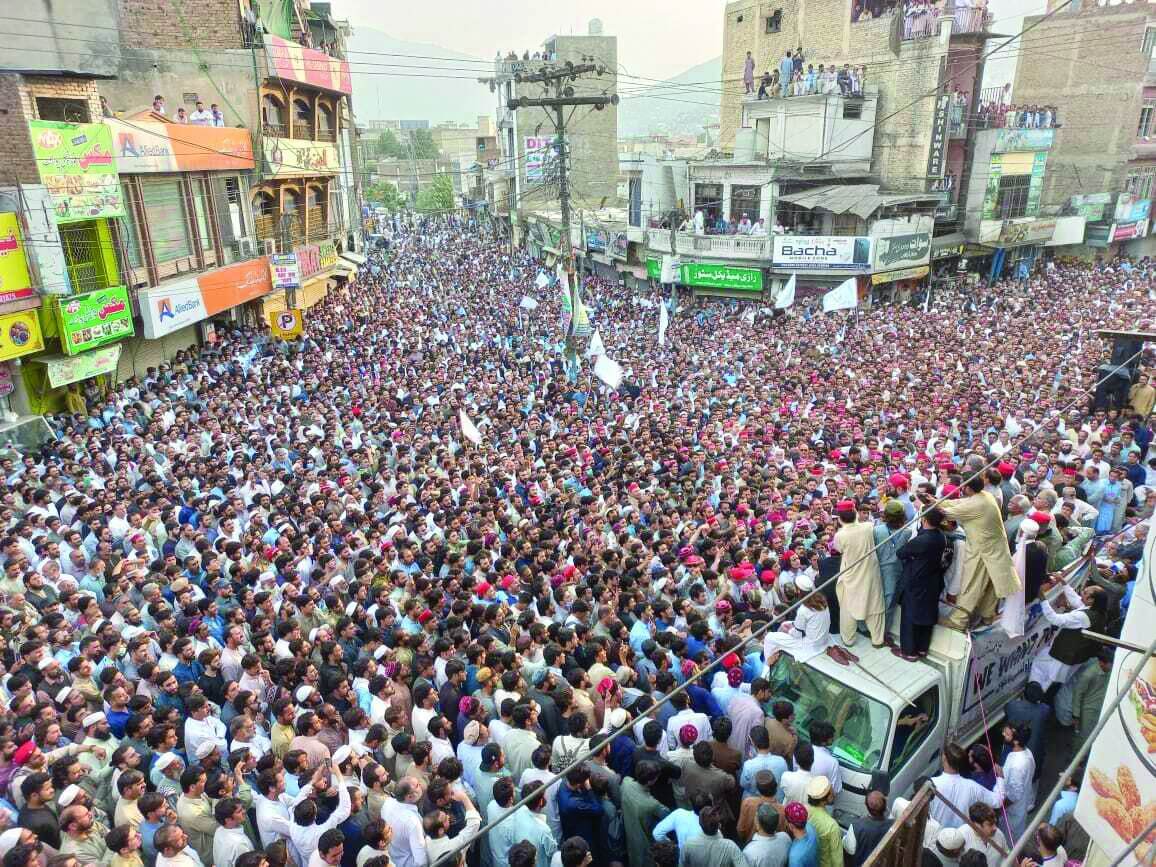Thousands of people gathered in Swat Valley over the last two days ended their protest against increasing militancy in the region after successful discussions with the region’s deputy commissioner and federal government officials.
The protests first began on Monday, after a fatal gun attack on a school van driver by unidentified assailants that also left two children injured. The demonstrations eventually spread to other parts of the Khyber Pakhtunkhwa (KP) province. Locals have blamed the outlawed Tehreek-i-Taliban Pakistan (TTP) for the attack, a claim refuted by the group.
The driver’s family first led a sit-in at Gulibagh and placed his body on the road, demanding that the orchestrators of the attack be arrested. The protests gained momentum among school students, teachers, and civil society members.
This is probably largest ever protest in the history of Swat. [Via @khorasandiary] https://t.co/h2lM1VrKSo pic.twitter.com/Wm3CyQ4bWf
— Iftikhar Firdous (@IftikharFirdous) October 11, 2022
The calls for justice and reform soon spread to Mingora, where demonstrators demanded “peace from the state,” failing which they vowed to march to Islamabad. Similar demonstrations were reported in the Haripur and Battagram districts too.
Speaking at a rally in Mingora, several prominent political and religious leaders raised concerns about the deteriorating peace in Swat and other parts of KP, lamenting authorities’ silence on the security situation in the province.
Senator Mushtaq Ahmed Khan said, “Every citizen of Pakistan has the constitutional right to safety ensured by the state. Unluckily, despite a massive defence budget, the state has completely failed to ensure peace here.”
Similarly, Pashtun Tahaffuz Movement chief Manzoor Pashteen highlighted that the region had already seen “bloodshed” from 2007 to 2009, when over two million people were displaced and properties were destroyed. In this regard, he blamed the Taliban’s return to power for “sabotaging” and disrupting hard-earned peace.
Likewise, the Human Rights Commission of Pakistan said, “It was callous and short-sighted to have downplayed the threat from militants given residents’ growing protests and calls for security.”
HRCP strongly condemns the terrorist attack on a school bus in #Swat. Swat's residents are right to hold the security forces responsible for failing to enforce the writ of the state. pic.twitter.com/PBEH4USm0E
— Human Rights Commission of Pakistan (@HRCP87) October 10, 2022
Responding to the protests, Interior Minister Rana Sanaullah chaired discussions with several prominent members of the national assembly, following which the Pakistani Prime Minister’s Steering Committee of Peace announced that the federal government would help the provincial government counter militancy in the province.
The protestors then dispersed after authorities vowed to arrest the assailants and take custody of the deceased’s children. The deputy commissioner also promised to compensate the victim’s family and enhance security in the region. Authorities also pledged to share all details about the investigation with a five-member body formed by the protestors.
A statement released after the meeting urged the opposition Pakistan Tehreek-e-Insaaf (PTI) party-led provincial government to focus on maintaining public order instead of concentrating on politics.
It was unanimously decided to abet the provincial government in curbing terrorist activities. The KPK government must ensure peace in the province rather than playing petty politics in the name of a long march against the federal government. (2/2)
— Rana SanaUllah Khan (@RanaSanaullahPK) October 12, 2022
This was a reference to former Prime Minister Imran Khan’s latest “Azadi March”, wherein he will lead PTI workers to Islamabad to protest against the Sharif administration. The release said, “Extremism and terrorism are on the rise in KP, but the provincial government is busy planning sit-ins against the federation.”
Meanwhile, KP government spokesperson Muhammad Ali Said said that the TTP should not be blamed for all the attacks, claiming that the group had agreed to claim responsibility for all terrorist acts that it had committed. He instead pointed to other groups that are active in KP, such as the Daulat Khan group and the Hafiz Gul Bahadur Group.
However, Member of the National Assembly Mohsin Dawar alleged that the TTP has formed a shadow government in Swat and called on the military and political leadership to hold discussions and sit together to resolve the issue.
The People are saying it loud and clear.
— Mohsin Dawar (@mjdawar) October 11, 2022
دہشتگردی نامنظور#SwatRejectsMilitancy pic.twitter.com/qd2V33aw9j
In fact, the Swat Valley was a TTP stronghold until 2009, when security forces forced the group out of the region. Since then, the area has seen infrastructural development and economic growth through local tourism.
However, with the Taliban’s rise to power in Afghanistan, the group began peace talks and ceasefire negotiations with the government and began paving the way to re-establish its presence in the region. This has in turn led to a rise in violence.
For example, an anti-Taliban tribal leader was attacked and killed in a bomb blast in Swat’s Kot Katai Village last month.
Monday’s attack came just a day after the 10th anniversary of the TTP-led attack on Malala Yousafazi, who was 15 years of age when she was shot in the side of her head. She survived the attack and has since become a vocal opponent of the Taliban and the TTP.

